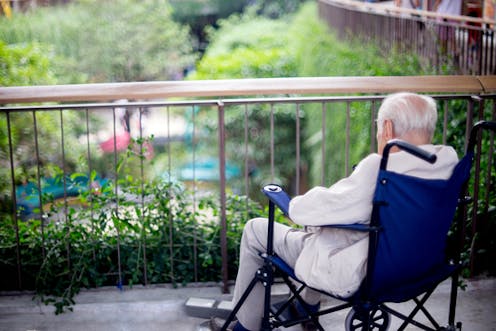Knowing the signs of Lewy body dementia may help speed diagnosis
Lewy body dementia is the second most common type of dementia. Why don't more people recognize the signs?

Lewy body dementia reached the public eye in 2014 after reports that Robin Williams died with diffuse Lewy body disease.
But, despite the fact that Lewy body dementia is the second most common dementia, it remains frequently unrecognized.
In one study, almost 70 percent of people diagnosed with Lewy body dementia saw three consultants before receiving the diagnosis. For a third of people with the disease, getting the correct diagnosis took more than two years.
October is Lewy Body Dementia Awareness Month. As a physician specializing in Lewy body dementia, I often hear patients and families describe delays in getting a diagnosis. It doesn’t have to be this way. Awareness is critical, particularly as new opportunities emerge for diagnosis and treatment.
What is Lewy body dementia?
The word “dementia” describes a condition affecting a person’s memory and thinking that is a decline from how he or she used to function and that is severe enough to affect day-to-day life. Alzheimer’s disease dementia and Lewy body dementia are the two most common types.
Lewy body dementia gets its name from the abnormal protein clumps that are seen on autopsies of the brains of people with Lewy body dementia. The protein alpha-synuclein – a protein found in the brain, not one you eat – clumps into spheres called Lewy bodies which can be seen using a microscope. These are named after F. H. Lewy, the person who first described them.
The diagnosis Lewy body dementia is an umbrella term that includes two different conditions: dementia with Lewy bodies and Parkinson’s disease dementia.

In dementia with Lewy bodies, a person develops memory and thinking problems before or at the same time as he or she develops movement problems that resemble Parkinson’s disease.
In Parkinson’s disease dementia, a person who has experienced Parkinson’s disease movement problems for years then also develops trouble with memory and thinking.
These two conditions share many of the same features. In addition to memory and thinking problems and movement problems, people with these conditions can have fluctuations in their alertness and concentration, hallucinations and paranoia, acting out dreams during sleep (something called REM sleep behavior disorder), low blood pressure with standing, daytime sleepiness and depression, among other symptoms.
Diagnosis is important
Getting the correct diagnosis is critical for patients and families. While no one wants to hear that they have a disease that currently can’t be cured, patients and families often feel relief that they finally have an explanation for what’s happening.
The diagnosis of Lewy body dementia is often missed due to lack of awareness by physicians, patients and families. Even for people eventually receiving a diagnosis of Lewy body dementia, research shows their first diagnosis is commonly incorrect. In that study, 26 percent of people later diagnosed with Lewy body dementia were first diagnosed with Alzheimer’s disease and 24 percent were given a psychiatric diagnosis like depression.
Knowing the correct diagnosis lets patients and families connect to resources such as the Lewy Body Dementia Association, an organization dedicated to helping people living with this disease. The organization provides education on Lewy body dementia, helps patients and families know what to expect, links patients and families to support and resources and connects them to research opportunities.
Once a diagnosis is made, physicians can also suggest potentially helpful treatments. Medications can include carbidopa/levodopa (Sinemet®), a drug that helps with slow movements, and cholinesterase inhibitors, which are drugs developed for Alzheimer’s disease that may also help people with Lewy body dementia.
Avenues for research
There is a great deal that we still need to learn about the Lewy body dementias. Increasing research is a priority of the National Institutes of Health.
Earlier this year, experts published new criteria for the diagnosis of dementia with Lewy bodies, aiming to improve accurate diagnosis.
There are also currently multiple research studies trying to find drugs to help people with Lewy body dementias, including studies to investigate drugs hoped to improve thinking, hallucinations and walking.
For Parkinson’s disease dementia, a new drug called pimavanserin was approved by the Food and Drug Administration in 2016 to treat hallucinations. Current research studies are testing drugs hoped to improve memory and thinking.

Scientists also hope to learn more about the alpha-synuclein protein clumps in the Lewy body diseases. Recent vaccine studies suggested that the body might be able to create antibodies against alpha-synuclein. This could be the first step toward a vaccine to help people with Parkinson’s disease and dementia with Lewy bodies. If effective, a vaccine would prompt the immune systems of people with these diseases to create antibodies to attack and clear the protein clumps.
With advances in diagnosis and treatment, there is reason for hope.
Melissa J. Armstrong is the director of the Lewy body dementia clinic at the University of Florida Center for Movement Disorders and Neurorestoration.
Read These Next
Americans have had their mail-in ballots counted after Election Day for generations − a Supreme Cour
29 states allow mail-in ballots postmarked by Election Day to be counted days after an election. A case…
Live healthier in 2026 by breathing cleaner air at home
An atmospheric chemist offers quick, easy and inexpensive suggestions to reduce indoor air pollution.
Meth inflames and stimulates your brain through similar pathways – new research offers potential ave
Researchers identified a key molecule that highlights how the immune system is linked to the release…






